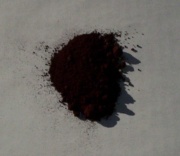Difference between revisions of "Lead dioxide"
Jump to navigation
Jump to search
| (One intermediate revision by one other user not shown) | |||
| Line 8: | Line 8: | ||
lead (IV) oxide; brown lead oxide; anhydrous plumbic acid; lead peroxide; lead superoxide; magistry of lead; precipitated oxide of lead; plattnerite; oxid olovièitý (Ces.); plumbic acid (when hydrated) | lead (IV) oxide; brown lead oxide; anhydrous plumbic acid; lead peroxide; lead superoxide; magistry of lead; precipitated oxide of lead; plattnerite; oxid olovièitý (Ces.); plumbic acid (when hydrated) | ||
| − | + | == Risks == | |
| − | == | + | * Fire risk in contact with organic materials. |
| + | * Toxic by inhalation or ingestion. | ||
| + | * Skin contact may cause irritation or ulcers. | ||
| + | * Carcinogen, teratogen, suspected mutagen. | ||
| + | * Fisher Scientific: [https://beta-static.fishersci.com/content/dam/fishersci/en_US/documents/programs/education/regulatory-documents/sds/chemicals/chemicals-l/S25380.pdf SDS] | ||
| + | ==Physical and Chemical Properties== | ||
Soluble in hydrochloric acid with the evolution of chlorine. Soluble in dilute nitric acid in the presence of peroxide or oxalic acid. Soluble in hot alkaline solutions and glacial acetic acid. | Soluble in hydrochloric acid with the evolution of chlorine. Soluble in dilute nitric acid in the presence of peroxide or oxalic acid. Soluble in hot alkaline solutions and glacial acetic acid. | ||
| Line 23: | Line 28: | ||
|- | |- | ||
! scope="row"| Melting Point | ! scope="row"| Melting Point | ||
| − | | 290 (dec) | + | | 290 C (dec) |
|- | |- | ||
! scope="row"| Density | ! scope="row"| Density | ||
| − | | 9. | + | | 9.38g/ml |
|- | |- | ||
! scope="row"| Molecular Weight | ! scope="row"| Molecular Weight | ||
| Line 32: | Line 37: | ||
|} | |} | ||
| − | == | + | ==Resources and Citations== |
| − | |||
| − | |||
| − | |||
| − | |||
| − | |||
| − | |||
| − | |||
| − | |||
* Richard S. Lewis, ''Hawley's Condensed Chemical Dictionary'', Van Nostrand Reinhold, New York, 10th ed., 1993 | * Richard S. Lewis, ''Hawley's Condensed Chemical Dictionary'', Van Nostrand Reinhold, New York, 10th ed., 1993 | ||
| Line 48: | Line 45: | ||
* ''The Merck Index'', Martha Windholz (ed.), Merck Research Labs, Rahway NJ, 10th edition, 1983 Comment: entry 5424 | * ''The Merck Index'', Martha Windholz (ed.), Merck Research Labs, Rahway NJ, 10th edition, 1983 Comment: entry 5424 | ||
| − | * Wikipedia | + | * Wikipedia: http://en.wikipedia.org/wiki/Lead_dioxide (Accessed Feb. 2, 2006) |
[[Category:Materials database]] | [[Category:Materials database]] | ||
Latest revision as of 09:33, 16 September 2022
Description
A dark brown powder that occurs in nature as the mineral plattnerite. Lead dioxide is used to make the striking surface of matches, the electrodes in lead acid batteries, and as a Mordant. It is also used as an oxidizing agent in the manufacture of dyes.
Synonyms and Related Terms
lead (IV) oxide; brown lead oxide; anhydrous plumbic acid; lead peroxide; lead superoxide; magistry of lead; precipitated oxide of lead; plattnerite; oxid olovièitý (Ces.); plumbic acid (when hydrated)
Risks
- Fire risk in contact with organic materials.
- Toxic by inhalation or ingestion.
- Skin contact may cause irritation or ulcers.
- Carcinogen, teratogen, suspected mutagen.
- Fisher Scientific: SDS
Physical and Chemical Properties
Soluble in hydrochloric acid with the evolution of chlorine. Soluble in dilute nitric acid in the presence of peroxide or oxalic acid. Soluble in hot alkaline solutions and glacial acetic acid.
| Composition | PbO2 |
|---|---|
| CAS | 1309-60-0 |
| Melting Point | 290 C (dec) |
| Density | 9.38g/ml |
| Molecular Weight | mol. wt. = 239.2 |
Resources and Citations
- Richard S. Lewis, Hawley's Condensed Chemical Dictionary, Van Nostrand Reinhold, New York, 10th ed., 1993
- Susan E. Schur, Conservation Terminology: A review of Past & Current Nomenclature of Materials, Technology and Conservation, Spring (p.34-39); Summer (p.35-38); Fall (p.25-36), 1985
- The Merck Index, Martha Windholz (ed.), Merck Research Labs, Rahway NJ, 10th edition, 1983 Comment: entry 5424
- Wikipedia: http://en.wikipedia.org/wiki/Lead_dioxide (Accessed Feb. 2, 2006)
